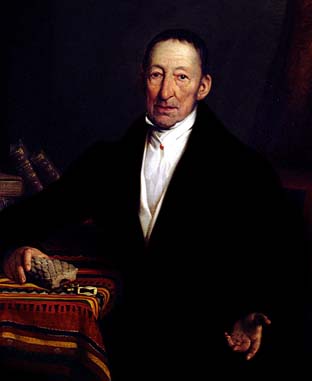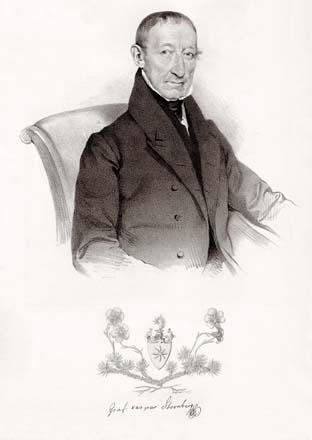Life of Count Kašpar Maria Sternberg

Count Kašpar Maria Sternberg was born in Prague on January 6, 1761. He was the third son of Count Jan Nepomuk Sternberg and Countess Ann Krakovská of Kolowraty, the daughter of the highest royal Burgrave of the Bohemian Kingdom. The oldest son, Jan Nepomuk, pursued a military career. The middle brother, Joachim, also became a soldier, though he was more interested in physics, chemistry and mineralogy. As the youngest son, Kašpar was destined for the clergy, and his parents secured such posts for him in Regensburg and Freisig in Germany. Thus, Kašpar Sternberg went to study theology at the Collegium Germanicum in Rome in 1779. He completed his studies in 1782 and took the post of a canon in Regensburg in 1785, and then in Freisig shortly thereafter. In 1802 the Archbischop of Mainz, Karl Dahlberg, appointed Sternberg to be vice-president of the commissariat for establishing a new municipal confederation consisting of Aschaffenburg and Regensburg Preincipates and Wetzlar, the president of which would be the archbishop Carl Theodor von Dahlberg. Though he enthusiastically began his involvement in politics. However, difficulties and intrigues disappointed him after several years. He later wrote in his autobiography that he had found peace of mind in the study of natural science, especially in botany, which soon brought about a turning point in his life. Sternberg´s interest in botany had been raised by the president of the Botanical Society of Regensburg, Count Bray, who became his friend and later the first translator of his work. In 1804 Sternberg accompanied archbishop Dahlberg to Paris, where he participated in the coronation of Napoleon as the Emperor of France. Sternberg met many outstanding natural historians during this journey. When visiting Count Faujas de Sant Fond, he studied the impressions of fossil plants from England, which reminded him of similar specimens in the collection of his brother Joachim. At the same time he saw the first edition of Schlotheim´s Beschreibung Merkwürdiger Kräuter - Abdrücke und Pflanzen Versteinerungen. All of this greatly inspired Sternberg´s interest in palaeobotany.

Sternberg had to leave his ecclesiastic and political career also due to family events. Both his brothers had died - Jan Nepomuk in 1789, and Joachim in 1808. As the only Count from the Leopoldov branch of the Sternberg family, Kašpar was obligated to manage the family estates. In August of 1806 Sternberg resigned from his position as vice-president of the municipal confederation. In 1810 he moved from Regensburg to the castle at Březina in Central Bohemia. Before long he met a mineralogist and botanist named Lindacker, and a mine surveyor and entomologist named Preissler; with the latter he visited various mines where he inspected fossil plants in their original localities for the first time. Both his new friends helped him to organize and exhibit his brother´s mineral collection in the castle of Březina.
Even as early as his appointment in Regensburg, Sternberg had begun studying the Alpine flora of Germany, Salzburg, Tyrol, Carinthia and Italy. The results of his work were published in a three-volume monograph entitled "Revisio Saxifragarum iconibus illustrata", published successively in 1810, 1821 and 1831 in Regensburg and Prague.
In 1814 Sternberg visited Graz to inspect the newly established Johanneum museum. It was there that the idea of a Czech national museum occurred to him. He soon interested the highest Burgrave of the Bohemian Kingdom, Count František Kolovrat Libštejnský, about this idea. The latter then issued an appeal with the title "To patriotic friends of science" on April 15, 1818, wherein he emphasized the necessity of founding the Patriotic Museum of Bohemia. The Society of the Patriotic Museum of Bohemia was founded in response to this appeal, and began its active existence on December 23, 1822. Count Sternberg was elected president of this organization during the first meeting. As the most prominent scientific personality of the museum, and as a representative of the Czech aristocracy, he guaranteed its social prestige. At the Society’s opening meeting he announced that he would donate his entire natural history collection and science library to the museum. By that time, Sternberg had 9000 species of plants in his herbarium and a library of more than 4000 volumes, while the geological collection that he and Lindacker had amassed consisted of about 5000 mineral specimens and 1400 fossils.
Equipped with a knowledge of botany, Sternberg had begun studying fossil plants and preparing the first edition of his work, Versuch einer geognostisch botanischen Darstellung der Flora der Vorwelt (A Geognostic Botanical Account of Prehistoric Flora) in 1815. He travelled around Europe, making excursions, meeting many researchers and collectors, and examining their collections. Among the scientists who became his friends were Schlotheim in Gotha, Goethe in Weimar, Noeggerath in Bonn, Münster in Bayreuth, Agardh and Nilson in Lund, and Buckland at Oxford. His classification of fossil plants used the modern approach directly inspired by botany, which sharply contrasted the methods of earlier authors (Schlotheim, Rhode, Steinhauer) who considered fossils simply as curiosities of nature. The first volume of Versuch einer geognostisch botanischen Darstellung der Flora der Vorwelt Sternberg was finished in 1825. Then he needed some more time to accumulate new material, but continued working. In 1833 he finished the fifth and sixth parts. The last parts 7-8 of the second volume were arranged in cooperation with the young scientists Karel Bořivoj Presl and Josef August Corda who helped him to finish the work. The second volume was issued in 1838 shortly before Kašpar Sternberg died.

Sternberg’s collection of fossil plants, which was mentioned by Humboldt as the best and largest in the world, is still one of the most valuable parts of the National Museum’s holdings.
As president of the National Museum, Sternberg was attentive to its scientific background. Together with František Palacký, he founded the first Czech scientific journal: Časopis společnosti vlasteneckého museum v Čechách (The Journal of the Society of the National Museum in Bohemia). In 1838 he organized the first international conference of natural scientists in Prague. He also initiated the purchase of the important herbarium of the botanist Tadeáš Haenke, containing numerous plants from South America.
An interesting aspect of Sternbergs’ life is his friendship with Johann Wolfgang Göthe. They met several times in West Bohemian spas, where they discussed natural science, philosophy, and the origins of rocks. Göthe initiated Sternbergs decision to mine a tunnel through the hill called Komorní hůrka (now known to be a Quaternary volcano) toward clearing up its origin.
The least-known aspect of Sternberg´s life is his economic activity. For example, he was the president of a joint-stock company for building railways, and a shareholder in the corporation for building a chain bridge in Prague.
In 1831, at the age of 74, Sternberg began to study the history of mining and mining law. After collecting data and sources for four years, he wrote the first part of his Umrisse einer Geschichte der böhmischen Bergwerke (Outlines of a History of Bohemian Mining). The first volume of this work was published in 1836, with the second part appearing the following year. In 1838 he published a further volume concerning the history of mining laws from the Middle Ages to the nineteenth century.
The significance of Kašpar Sternberg is not yet fully appreciated. He put natural science in Bohemia on new, higher level and contributed to its recognition in Europe. His activities, particularly the foundation of the National Museum as a centre for science in Bohemia and the stimulation of young scientists in working in science had great impact for the whole country. On the international stage he was the founder of scientific palaeobotany and very important was also his efforts in developing international scientific collaboration. Kašpar Maria Sternberg died on December 20, 1838.